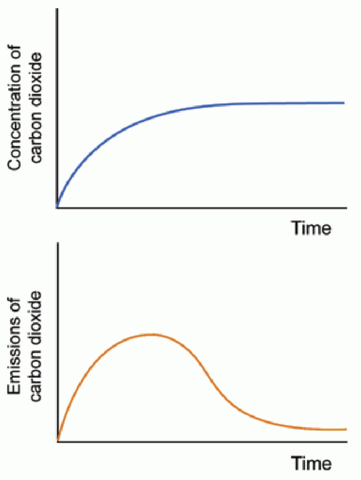 |
This is a file from the Wikimedia Commons. Information from its description page there is shown below.
Commons is a freely licensed media file repository. You can help.
|
Summary
| Description |
English: The image shows how stabilizing the atmospheric concentration of carbon dioxide at a constant level would require carbon dioxide emissions to be effectively eliminated. The graph on the bottom shows a substantial reduction in carbon dioxide emissions from their present level over time. Carbon dioxide emissions peak then decline to a fraction of their current level. The graph on the top shows how this reduction would lead to the atmospheric concentration of carbon dioxide being stabilized at a constant level.
|
| Date |
2009-01-00 |
| Source |
The image is taken from the report, "Synthesis and Assessment Product 5.2: Best practice approaches for characterizing, communicating, and incorporating scientific uncertainty in decisionmaking," page 11. This report is freely available and can be downloaded from http://www.ipcc-wg2.gov/njlite_download.php?id=5805 |
| Author |
U.S. Climate Change Science Program and the Subcommittee on Global Change Research (Granger Morgan, H. Dowlatabadi, M. Henrion, D. Keith, R. Lempert, S. McBride, M. Small, T. Wilbanks (eds.)). National Oceanic and Atmospheric Administration, Washington D.C., USA. |
Permission
( Reusing this file) |
http://www.ngdc.noaa.gov/ngdcinfo/privacy.html
|
 |
This is a retouched picture, which means that it has been digitally altered from its original version. Modifications: Changed graph placement from horizontal to vertical.
|
Licensing
| Public domainPublic domainfalsefalse |
 |
This image is in the public domain because it contains materials that originally came from the U.S. National Oceanic and Atmospheric Administration, taken or made as part of an employee's official duties.
|
|
File usage
The following pages on Schools Wikipedia link to this image (list may be incomplete):
Schools Wikipedia was launched to make learning available to everyone. The world's largest orphan charity, SOS Children's Villages brings a better life to more than 2 million people in 133 countries around the globe. Will you help another child today?




